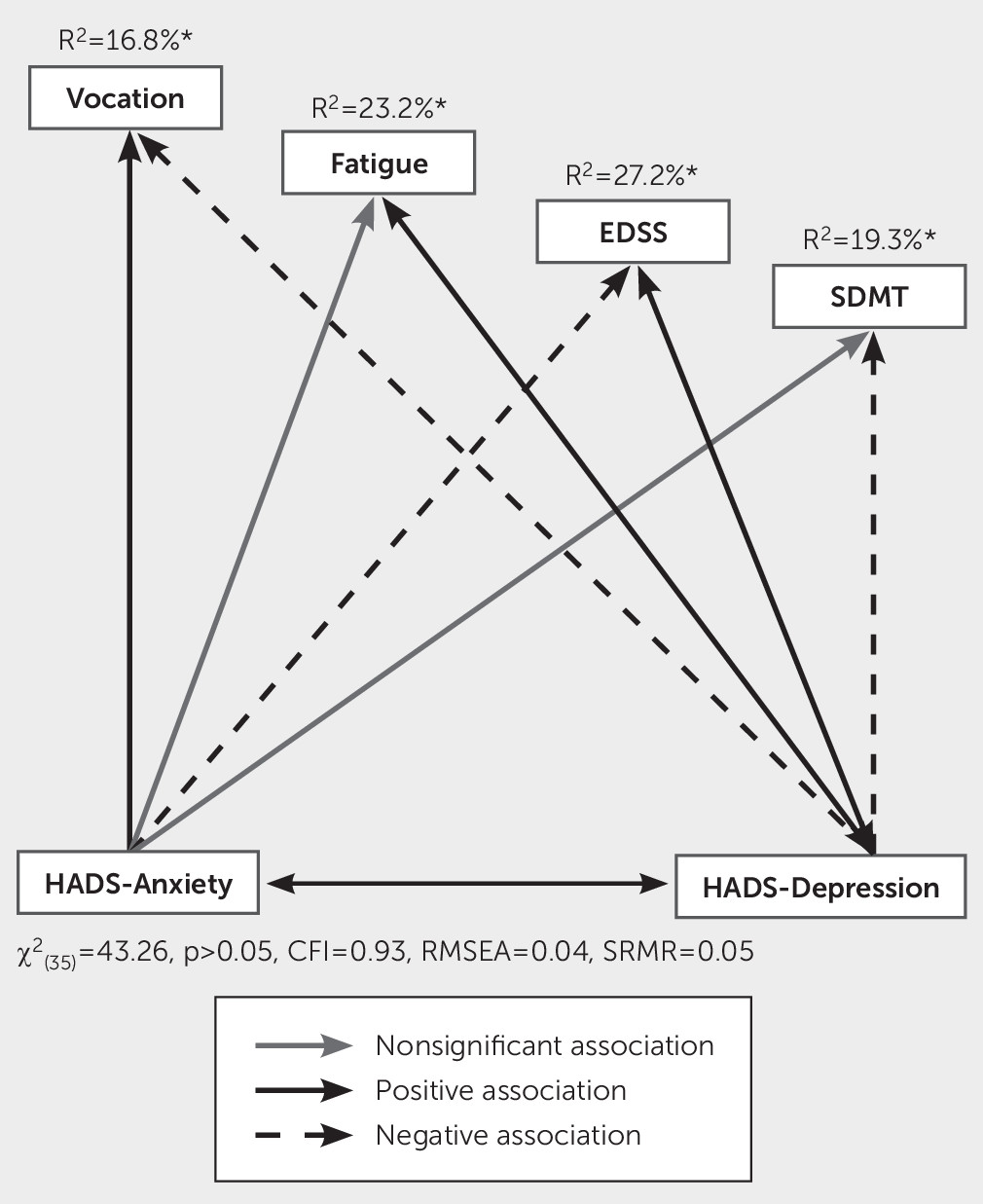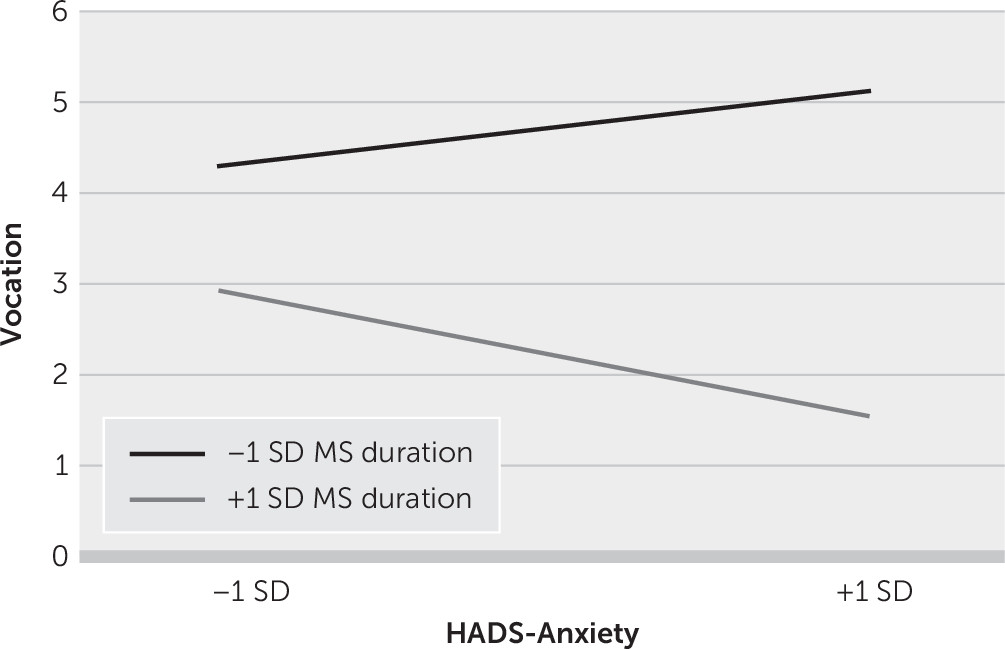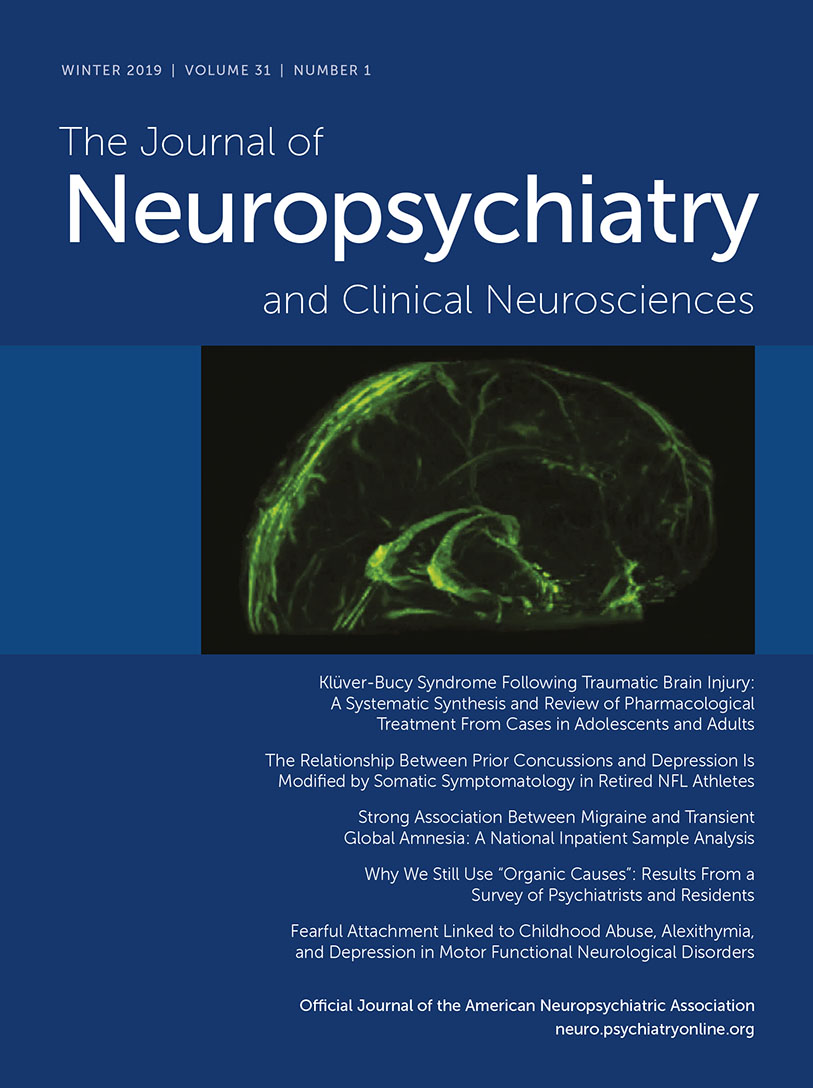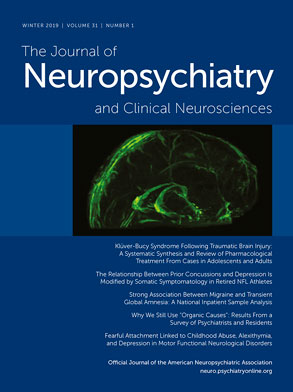The goal of the current study was to explore the differential impact of depressive and anxiety symptoms, measured by the Hospital Anxiety and Depression Scale (Depression subscale [HADS-D] and Anxiety subscale [HADS-A]), on functional outcomes among people with MS. The functional outcomes investigated because of their impact on quality of life among people with MS were employment status; fatigue, as measured by the Fatigue Severity Scale (FSS); physical disability, as measured by the Expanded Disability Status Scale (EDSS); and cognition and processing speed, as measured by the Symbol Digit Modalities Test (SDMT).
Methods
Participants
A retrospective chart review was conducted among people with MS who attended the MS Cognitive Clinic at Parkwood Hospital (London, Ontario, Canada) between January 2011 and December 2014. Individuals included in the study met the following criteria: were between the ages of 18 and 59; were diagnosed with MS (any type) on the basis of McDonald’s criteria;
12 were tested with the HADS; had at least a ninth-grade education; and were fluent in English. People with MS were excluded if they had a history of psychiatric or neurological disease with the potential to cause cognitive impairment, including but not limited to bipolar disorder, schizophrenia, posttraumatic stress disorder, learning disability, dementia, or traumatic brain injury; had received corticosteroids or had a relapse in the last 30 days prior to the cognitive testing; or had reported current drug abuse, specifically daily use of marijuana.
For each participant, background information collected from the clinical charts included demographic characteristics (gender, age, education, current psychiatric medication use, and history of depressive symptoms [previous diagnosis of depression or treatment with antidepressant drugs]), MS history (type of MS, years since diagnosis), EDSS score, and vocational status (seven categories: unemployed with objective disability, qualifies for disability benefits; unemployed with subjective disability, does not qualify for disability benefits; unemployed with no disability; stay-at-home parent or student; employed part time, 10–20 hours per week; employed full time with reduced capacity; and employed full time). Participants who listed retired as their vocational status were excluded from this study.
Standard Protocol Approvals and Patient Consent
This retrospective chart review was approved by the Health Sciences Research Ethics Board at Western University, London, Ontario, Canada.
Measures
HADS-A and HADS-D.
Depression and anxiety symptoms were assessed with the HADS, a 14-item self-report measure with seven items each in the depression and anxiety subscales.
13 Each item was scored on a scale of 0–3, with a total potential score of 21, with higher scores corresponding with severity of symptoms. In a validation study, a cutoff of 8 was identified to demonstrate high sensitivity and specificity for both the HADS-D (sensitivity:77%, specificity: 87.3%) and the HADS-A (sensitivity: 88.5%, specificity: 80.7%). Thus, it is a well-validated measure for screening depression and anxiety within the MS population.
14,15FSS.
Fatigue was measured with the seven-item FSS, which has been validated among individuals with MS.
16,17 Each question is scored on a Likert-style 1–7 scale (“strongly disagree” to “strongly agree”). The total score is the average of the nine items and can range from 1 to 7, with a higher score indicating more severe fatigue.
EDSS.
Disability was measured with the EDSS, an ordinal scale of 0.0–10 (“no disability” to “death due to MS”), with higher scores reflecting greater level of disability.
18SDMT.
The SDMT is a validated measure
19,20 for people with MS and is used to test processing speed. The participant is presented with a paper (8.5×11 in.) that consists of a series of single digits paired with nine symbols, as a reference key. During the test, the examinee views a pseudorandomized sequence of these symbols and orally responds with the matching digit. The total score is the number of correct responses within 90 seconds, with higher numbers corresponding to faster processing speed.
Statistical Analysis
We performed exploratory structural equation models (SEMs) to examine the differential effect of HADS-D and HADS-A on functional outcomes, specifically vocational status, EDSS score, FSS score, and SDMT performance. This accounted for shared associations among all the variables of interest in the study, with age, education, gender, psychiatric medication use, depression of history, MS duration, and MS course serving as covariates. The advantage of this SEM approach is that it allowed us to examine how depression and anxiety scores were associated with each outcome simultaneously, while controlling for the interrelation between depression and anxiety scores and also accounting for the effects of a number of covariates. The fit of the model to the data was examined with typical fit indices used in SEM: chi square, comparative fit index (CFI), root-mean-square error of approximation (RMSEA), and standardized root-mean-square residual (SRMR). Significant beta values reflect the standard deviation differences in the outcomes on the basis of a one standard deviation difference in the predictors.
Results
There were 128 charts that met the inclusion criteria and were therefore included in this study. There were more females than males (males, N=33; females, N=95; mean age, 46.32 years [SD=8.23]), with a mean education of 13.95 years (SD=2.4). The mean duration of MS diagnosis was 12.21 years (SD=7.99); the majority of the sample (N=92 [71.9%]) had a relapsing-remitting MS course, followed by secondary progressive (N=30 [23.4%]) and primary progressive (N=6 [4.7%]). The median EDSS score was 3.0 (range, 0.0–7.0). According to HADS criteria, 38% of participants met the cutoff for depression, and 57% met the cutoff for anxiety. The correlations among demographic characteristics, depression, anxiety, and the functional outcomes are reported in
Table 1.
The first model controlled for any effects of gender, age, education, MS course, MS duration, psychiatric medication use, and history of depression on the outcomes (vocation, FSS, EDSS, and SDMT) without the main predictors (HADS-A and HADS-D). Education was a positive correlate of vocation (β=0.16, p<0.05) and SDMT (β=0.23, p<0.05). MS course was positively correlated with EDSS (β=0.40, p<0.05) and FSS (β=0.17, p<0.05). Moreover, MS duration was positively associated with EDSS (β=0.22, p<0.05). Together, the covariates explained 11.8% of the variability in employment, 8.8% in fatigue, 25.6% in EDSS, and 15.0% in SDMT.
Next, we added the effect of HADS-A and HADS-D as predictors of the outcomes. HADS-A (mean=8.41 [SD=3.98]) and HADS-D (mean=6.23 [SD=3.85]) scores were strongly positively correlated with each other (r=0.52, p<0.05). Moreover, both HADS-A and HADS-D were correlated with psychiatric medication use (r=0.20, p<0.05, and r=0.23, p<0.05, respectively). After we controlled for covariates, HADS-D was positively correlated with FSS (β=0.37, p<0.05) and EDSS (β=0.26, p<0.05) and negatively correlated with both vocation (β=–0.32, p<0.05) and SDMT (β=–0.28, p<0.05). That is to say that depressive symptoms were associated with higher fatigue and physical disability and with lower employment and processing speed (
Figure 1).
In contrast, HADS-A was negatively associated with EDSS (β=–0.22, p<0.05). This meant that higher anxiety symptoms were linked with lower physical disability values. Moreover, there was a significant positive association between HADS-A and vocation (β=0.23, p<0.05). Together, HADS-A and HADS-D explained 5% of the variability in employment, 14.5% in fatigue, 1.6% in EDSS, and 4.3% in SDMT, beyond the effects of the covariates. The resulting model was a good fit to the data (χ2=43.26, df=35, p>0.05, CFI=0.93, RMSEA=0.04, SRMR=0.05).
To further investigate the positive association between HADS-A and vocation noted above, we explored potential interactions with each of the covariates. Unlike other covariates, the anxiety-by-MS duration interaction term, when added to the model, was found to be statistically significant (β=–0.18, p<0.05). As shown in
Figure 2, at high levels of anxiety, short MS duration was associated with high levels of vocation, as opposed to long MS duration. The addition of the anxiety-by-MS duration interaction explained an additional 6% of the variability in vocation, and the resulting model was an acceptable fit to the data (χ
2=49.86, df=39, p>0.05, CFI=0.91, RMSEA=0.05, SRMR=0.05).
Last, as fatigue may affect depressive symptoms, we examined whether the impact of HADS-D on functional outcomes stated previously is due to fatigue. Given the significant correlation between the FSS and HADS-D (r=0.45, p<0.05), we ran a new model with FSS added to the original model covariates. The resulting model showed unacceptable model fit (χ2=43.56, df=24, p<0.05, CFI=0.88, RMSEA=0.08, SRMR=0.07). Despite this, HADS-D remained significantly associated with EDSS (β=0.17, p<0.05) and negatively correlated with both vocation (β=–0.18, p<0.05) and SDMT (β=–0.18, p<0.05). These results thus indicate that the effect of HADS-D on outcomes examined is not entirely driven by the impact of fatigue on depressive symptoms. In regard to HADS-A, the new model revealed similar results to the original model (HADS-A and EDSS, β=–0.23, p<0.05; HADS-A and vocation, β=0.22, p<0.05).
Discussion
The present study examined the differential impact of depressive and anxiety symptoms as measured by the HADS on functional outcomes among people with MS. Higher depressive symptoms were associated with higher fatigue and physical disability and with lower employment and processing speed, whereas higher anxiety symptoms were related to lower physical disability and remaining employed, with fewer restrictions. These findings indicate that depressive symptoms have a more disabling impact on functional outcomes among people with MS relative to anxiety symptoms; thus, this result highlights the importance of giving precedence to assessing and treating depression symptomatology in a clinical context among people with MS.
Although depressive symptoms among people with MS have been linked to fatigue, disability, cognitive impairment, and transition to unemployment,
21–25 the overlap with anxiety symptoms is rarely considered. With this overlap taken into account, the findings of this study are consistent with past research and, it is important to note, demonstrate a differential negative impact of depressive symptoms on functional outcomes among people with MS. Unlike the sizable impact depressive symptoms had on fatigue, disability, and cognition, depressive symptoms were only a relatively weak predictor of vocational status, which may be influenced by environmental factors such as difficulty in the workplace (e.g., lack of accommodation and support by employers, inflexible work hours, and hostility).
26 Moreover, lack of a refined assessment measure for vocational status might have accounted for the weak relation observed in our study, particularly given the absence of information on types of jobs,
25 working hours,
27 or job characteristics (e.g., complexity, physical and cognitive demands).
28It should also be noted that each of the functional outcomes examined in this study can feed back to alter mood functioning. As reviewed by Arnett et al.,
29 following MS onset, common sequelae of MS, such as fatigue, physical disability, and cognitive dysfunction, can further increase the risk of depression, with this relationship moderated by levels of stress, coping style, social support, and conceptions of self and illness. Thus, there likely exists a complex and potentially dynamic relationship between depression and functional outcomes in MS, which will only be elucidated in future work with a longitudinal approach.
In previous studies, anxiety symptoms among people with MS have been shown to be negatively associated with MS-related disability, fatigue, unemployment, and cognitive function.
11,24,30–33 In contrast, when we accounted for commonality with depressive symptoms in this study, we found no significant association between anxiety symptoms and fatigue, on the one hand, and cognitive function, on the other. This may be due to differences between our study and other research, particularly the absence of control for the depression-anxiety overlap in other studies;
24,30,32,33 the use of a cross-sectional study design with limited control;
26 and the inclusion of participants with severe symptomatology, as opposed to our largely mild to moderate sample.
32 It should be noted that we observed a positive association between anxiety symptoms and employment. Further exploratory analysis revealed that this relationship was moderated by disease duration, such that patients with higher levels of anxiety who were earlier in the course of their disease were more likely to be employed compared with patients with higher levels of anxiety who were later in their disease course. This suggests that as disease burden increases (as represented by disease duration), anxiety has a detrimental impact on employment. Future research should investigate the replicability of this finding and explore the mechanisms underlying these relationships.
We observed that at higher anxiety level, physical disability was lower, a finding contrary to previous work.
34 Disability identity, defined as acceptance and integration of one’s status as a person with disability, may explain the results observed. Strong disability identity is associated with low psychological distress and, hence, lower levels of anxiety
35; thus, it may be that with low disability identity (associated with low disability), individuals experience high levels of anxiety because they have yet to accept and adapt to their disability status and are more likely to worry about the negative impact of MS. It is also possible that this disconnect between anxiety levels and disability is due to the personality changes that occur over time among people with MS.
36 This relationship needs to be studied in more depth.
There were a few limitations to this study. The retrospective nature of the study limits our ability to identify the direction of causality between mood and functional variables. In addition, self-report measures of mood function were available on this sample, as opposed to formal psychiatric diagnosis. Moreover, patients with mild to moderate depressive and anxiety symptoms with relapsing-remitting MS were overrepresented in our sample; thus, the findings cannot be easily extended to those with more severe mood symptoms and alternative MS diagnosis. Whereas we were able to identify current psychiatric medication use and history of depression for patients in this study, history of anxiety was not evaluated. It should be noted that a history of anxiety was not well documented and thus cannot be commented on in this analysis. It is well known that anxiety is underrecognized and understudied in the MS population,
37,38 which thus affected our ability in this retrospective study to fully account for a history of anxiety or anxiety disorders.



